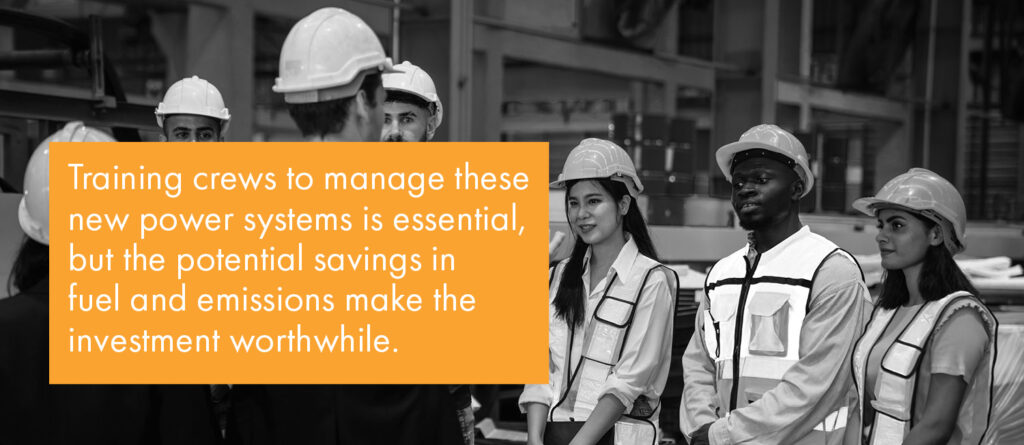In the modern world, staying competitive means embracing new technologies that drive growth, efficiency, and sustainability. The inland marine industry is no exception.
At BargeOps, we’re committed to helping barging businesses modernize their operations, and one of the most significant opportunities we see today is the move toward electrification. This shift isn’t just about regulatory compliance: It’s a strategic decision that can reshape the future of your business. As global environmental regulations tighten, the pressure to reduce greenhouse gas (GHG) emissions is mounting. Early adopters of electrification are positioning themselves ahead of these regulatory changes, capitalizing on the opportunity to become industry leaders in sustainability.
Beyond compliance, electrification offers tangible operational benefits. Electric and hybrid systems significantly reduce fuel costs, minimize maintenance, and increase uptime. In an industry where every hour counts, the ability to minimize downtime and maintenance costs while boosting operational performance is a game-changer.
Trends in Boat Electrification
As technology evolves, several promising developments are emerging, each offering unique opportunities for businesses looking to go electric.
1. Battery Technology Advancements
The cornerstone of the electrification movement is the rapid advancement in battery technology. Modern lithium-ion batteries, while expensive, have the highest energy density compared to other types of batteries. For example, Zero Emission Services, a Netherlands-based company, has developed a battery pack that enables a boat to travel 60 to 120 km, or 2 to 4 hours, without fuel. These batteries are charged with green energy, ensuring that the boat’s electrical powertrain emits no CO2, nitrogen, or particulate matter.
Over time, the efficiency of these batteries decreases by only about 20% after a decade of use. However, they remain useful in other applications, such as stabilizing electricity grids, powering events, or providing shoreside power. Battery-powered inland waterway vessels are currently rare in the U.S., but grants like the U.S. Environmental Protection Agency’s (EPA) Diesel Emissions Reduction Act (DERA) are helping fund conversions, as seen with the first zero-emissions river ferry in 2020.
2. Shore Power Development
Electrification isn’t just about what happens on the water; it also requires changes at ports. According to the EPA, switching to shore power can reduce overall pollutant emissions by up to 98%, which is crucial for the health and safety of port city communities. However, many U.S. ports currently lack the infrastructure to connect vessels to shore power. Some, like Port NOLA, have already made commitments to install shore power systems by 2028, allowing vessels to connect to onshore electricity and turn off diesel engines while docked.
3. Hybrid Systems
While shore power further develops, hybrid systems offer a practical transitional solution. Hybrid vessels, which combine diesel and electric power, provide the flexibility to gradually shift towards fully electric operations without significant disruptions. These systems optimize fuel use and reduce emissions while allowing for continued operation in areas where charging infrastructure may not be available.
Maturing tugboats retrofitted with hybrid diesel-electric engines can achieve up to 10% more fuel efficiency and lower emissions. Retrofitting older vessels with new engines can reduce the propulsion load, and installing variable-speed generator sets can increase vessel efficiency by up to 20%. Training crews to manage these new power systems is essential, but the potential savings in fuel and emissions make the investment worthwhile.

4. Hydrogen Fuel Cells
While batteries are at the forefront of marine electrification, hydrogen fuel cells are also gaining traction as a viable alternative, particularly for longer-range operations. Hydrogen fuel cells offer the potential for zero-emission propulsion and can complement battery systems in hybrid configurations, providing an extended range and reducing reliance on diesel engines. For newly built vessels, considering hydrogen as a power source from the start can provide substantial benefits in sustainability and future-proofing against evolving regulations.
In May of 2023, Dutch shipping company Future Proof Shipping (FPS) launched the first hydrogen-powered zero-emissions inland container ship, H2 Barge 1, in Rotterdam, the Netherlands. After seeing success with the project, in March of 2024, the company completed its first trials for a second inland containership converted to run on hydrogen. Each vessel is expected to reduce greenhouse gas emissions by 2,000 tons of CO2e per year.
A Sustainable Future for the Industry and for Your Business
Innovative solutions to enhance sustainability in the barge industry are emerging at a rapid pace. Many options and practices are already in place, while others are in the early stages of research or being tested in markets outside the U.S., showing great promise for reducing carbon emissions. By staying informed and adapting to these trends, barge companies can play a significant role in creating a cleaner, greener environment.
As modernization continues to create competitive advantages in the industry, BargeOps is here to help you lead the way. Our software solutions are designed to modernize and streamline your operations, which will ultimately reduce delays and contribute to increased efficiency and lower fuel consumption. Contact us to learn how BargeOps can support your transition to a more sustainable and successful future.


